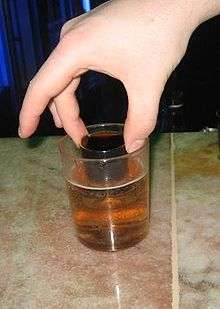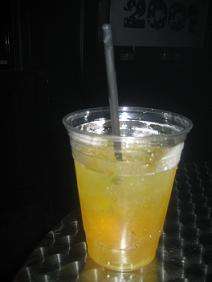Caffeinated alcoholic drink
A caffeinated alcoholic drink, or caffeinated alcoholic beverage, is a drink that contains both alcohol and caffeine. They often include the ingredients of energy drinks as well. In 2010 and 2011, this type of beverage faced criticism for posing health risks to their drinkers. In some places there is a ban on caffeinated alcoholic beverages.
Energy drinks are beverages that contain high doses of caffeine and an assortment of ingredients, such as,
- Taurine- amino acids
- Guarana- compound of stimulants- plant-based
- Ginseng - herbs
- B vitamins[1]
Effects
- Euphoria
- Overall improvement in mood
- Increased self-confidence
- Increased sociability
- Increased alertness and decreased fatigue
- Flushed appearance
- Increased metabolic rate
- Impaired fine muscle coordination
Health risks
The counteracting effects of caffeine and alcohol often causes the consumer to drink more than they normally would because of the delayed "drunk" feeling, as caffeine can mask some of the sensory cues individuals might normally rely on to determine their level of intoxication.[2] The consumption of this beverage and the delayed intoxication impairment could lead to negative consequences such as the increased stimulation and intoxication levels while decreasing the ability to operate a motor vehicle.[1]
The US Food and Drug Administration (FDA) has looked at peer-reviewed studies and has come to the conclusion that risky behaviors which could lead to life-threatening situations are directly correlated with the consumption of caffeinated alcoholic beverages.[2]
Research
Universities have conducted studies to compare the outcomes of the consumption of regular alcoholic drinks and of caffeinated alcoholic drinks. The University of Florida surveyed 802 college students who had mixed alcohol and caffeine, and found they were three times more likely to leave a bar highly intoxicated and four times more likely to want to drink and drive than drinkers who did not consume alcoholic energy drinks.[3] Another study surveyed 697 students from Wake Forest University and found that the students who had consumed caffeinated alcoholic beverages were more likely to drink and drive, take advantage of someone sexually, or end up needing medical treatment.[4] From this perspective, it is inferred that caffeinated alcoholic drinks cause one to act in ways that would be less likely if one were drinking non-caffeinated alcoholic drinks.
US reactions
The adverse effects of caffeinated alcoholic drinks have led to increased regulation. Under the Federal Food, Drug, and Cosmetic Act, a substance intentionally added to food (such as caffeine in alcoholic beverages) is deemed “unsafe” and is unlawful unless its particular use has been approved by FDA (Food and Drug Administration) regulation. The substance is subject to a prior sanction until the substance is Generally Regarded As Safe (GRAS).[5] In order for a substance to be characterized as GRAS, there must be sufficient evidence to prove its safety; this evidence should be generally known and accepted by qualified professionals.[4] The FDA did not approve the use of caffeine in alcoholic drinks, and thus the drinks cannot be legally marketed. As a result, the FDA sent letters to four manufacturers of caffeinated alcoholic beverages (Phusion Projects, Charge Beverages Corporation, New Century Brewing Company, and United Brands Company, Inc.) to alert them that the agency would be considering whether caffeine can lawfully be added to alcoholic beverages.[4] These letters also gave the manufacturers fifteen days to stop the addition of caffeine to the alcoholic drinks or to stop selling the drinks altogether.
The Federal Trade Commission (FTC) also took action against the four companies, warning that their marketing tactics might violate federal law and urging them to take swift and appropriate steps to protect consumers.[6]
The day before the FDA sent out the warning letters, Phusion Projects, a five-year-old Chicago company, said it would stop putting caffeine in the drinks and put a non-caffeinated version of the drink on the market in December 2010. In a statement, the company’s founders said that they still believed it was safe to blend caffeine and alcohol but wanted to cooperate with regulators.[6] The FDA continues work with Phusion Projects and other manufacturers to assure their products meet safety standards.[2]
International reactions
In Canada, regulations restrict the manufacture and sale of caffeinated alcoholic drinks unless the caffeine comes from natural sources such as guarana; manufactured caffeine cannot be directly poured into an alcoholic beverage.[4] In Mexico, caffeinated alcoholic drinks cannot be sold in bars or nightclubs. In Australia, the Ministerial Council on Drug Strategy is considering regulation to address the growing concerns over the drinks. The government of New South Wales is looking to ban the sale of the drinks from clubs and bars.[4] In Scotland, the Scottish Labour Party called for a ban on caffeinated drinks, such as the fortified wine Buckfast.[4]
Cocktails
See also
- Ban on caffeinated alcoholic beverages
- Alcoholic beverage
- Caffeinated beverage
- Guarana
- Taurine
- Vodka Red Bull
References
- 1 2 Marczinski, Cecile; Fillmore, Mark; Bardgett, Mark; Howard, Meagan (2011). "Effect of energy drinks mixed with alcohol on behavioral control:risks for college students consuming trendy cocktails.". Alcoholism: Clinical and Experimental Research. 35: 1282–92. doi:10.1111/j.1530-0277.2011.01464.x. PMC 3117195
 . PMID 21676002. Retrieved October 2014. Check date values in:
. PMID 21676002. Retrieved October 2014. Check date values in: |access-date=(help) - 1 2 3 United States. Department of Health and Human Services. Food and Drug Administration. Washington: GPO, 2010. http://www.fda.gov/NewsEvents/Newsroom/PressAnnouncements/ucm234109.htm
- ↑ "Dangerous Duo." State Legislatures 37.1 (2011): 10. Academic Search Premier. EBSCO. Web. 9 Feb. 2011. http://web.ebscohost.com/.
- 1 2 3 4 5 6 "U.S. Students Mourn Alcohol and Caffeine Drink Four Loko." UK Wired. 13 Dec. 2010. 11 Feb. 2011. http://www.wirednews.us/new.php/115036-US-students-mourn-alcohol-and-caffeine-drink-Four-Loko.
- ↑ "U.S. Food and Drug Administration: FDA to Look Into Safety of Caffeinated Alcoholic Beverages." Drug Week Newsletter 4 December 2009: page 1622. LexisNexis Academic. LexisNexis. Wash Coll Lib., Chestertown. 11 April 2011 http://libraryres.washcoll.edu:2371/hottopics/lnacademic/.
- 1 2 Goodnough, Abby. "F.D.A. Issues Warning Over Alcoholic Energy Drinks." The New York Times 18 November 2010, final ed.: A25. LexisNexis Academic. LexisNexis. Wash Coll Lib., Chestertown. 11 April 2011 http://libraryres.washcoll.edu:2371/hottopics/lnacademic/.
Further reading
- Leinwand, Donna. "Alcoholic Energy Drinks Targeted." USA Today 17 Nov. 2010, final ed.: A1. Academic Research Premier. EBSCO. Wash Coll Lib., Chestertown. 9 Feb. 2011 http://web.ebscohost.com/ehost/delivery?hid=104&sid=b764b9d3-c991-480e-8fe5-54c5e8a4441e%40sessionmgr104&vid=25.
- Johnson, Jenna and Kevin Sieff. "Four Loko Ban Fuels Buying Binge." Washington Post 18 Nov. 2010, final ed. 9 Feb. 2011 http://www.washingtonpost.com/wp-dyn/content/article/2010/11/18/AR2010111806114.html.
- "Parents sue makers of alcoholic energy drink after ‘wired’ son shot himself in 30-hour binge." Mail Online. 2010. Associated Newspapers Ltd. 9 Feb. 2011. http://www.dailymail.co.uk/news/article-1330274/Parents-sue-makers-Four-Loko-drink-son-shot-30-hour-binge.html.



